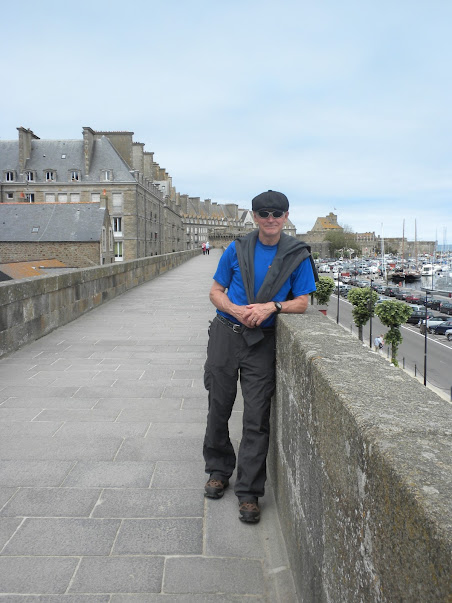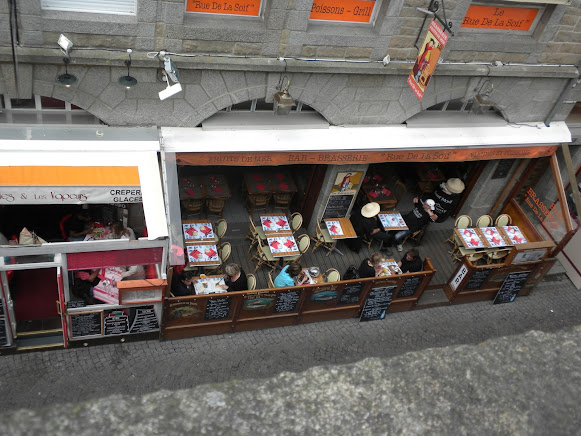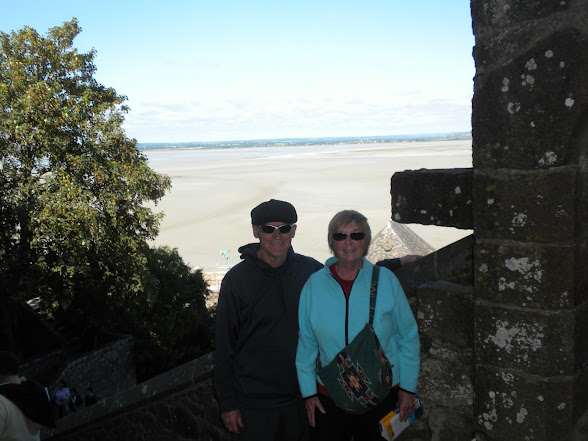"Just to travel is rather boring, but to
travel with a purpose is educational and exciting.” Sargent Shriver
Carol writes: By the time
we flipped the calendar page over to July, we had arrived in Brittany, that windswept
northwestern peninsula of France that sticks out into the Atlantic Ocean and along
the English Channel. Bretons have a
unique, fiercely independent streak that has strong Celtic ties. Unlike the rest of France, their highways
have no tolls, so that made traveling in that area very efficient.
We chose the
beach town of St. Malo for our stop in Brittany, and it turned out to be one of
those visits that ended up far exceeding expectations. Al is particularly fond of cities with
ramparts, so reading about St. Malo had gotten our attention. Little did we know that St. Malo’s 1-mile
walk on its ancient ramparts encircling the city would be so spectacular in
terms of scenery and history.
Fortunately,
the tide was out and we were able to walk on one of the most interesting
beaches I have ever visited. Tree trunks
were planted in the sand to serve as a breakwater for those fierce storms that
blow in off the English Channel.
The famous
poet Chateaubriand, whose grave is marked by a prominent cross, is buried on
one of these fortified islands.
Eighty
percent of St. Malo was destroyed by American bombs in WW II in the campaign to
liberate France. When the city was
rebuilt, it was done in an historic style to make it look old once again.
As we completed our circle of the old city on the ramparts, we were able to look down into attractive and inviting al fresco dining areas.
As we completed our circle of the old city on the ramparts, we were able to look down into attractive and inviting al fresco dining areas.
We left St.
Malo late in the afternoon with intentions to drive to Mont St-Michel so we
could view the abbey late in the day after many of the tourists and large tour
groups had left. Parking for visitors was
the most expensive we had come upon to date—the equivalent of $30 for a
motorhome—which is more than the cost of admission to the abbey! Al and I grumbled to each other about the
price, but since that was about the only option open to us, we took a parking
ticket and drove on into the spacious parking section set aside for RVs. From there it was about a 15-minute hike to
the free “navettes,” shuttle buses that traverse the causeway to the island and
drop tourists off a few hundred yards from the portal gate at the entrance to a
20-minute walk uphill to the abbey.
During our navette ride, we got our first really good view of Mont
St-Michel, and it was a stunner!
The abbey
sits atop what is basically a very small island that at high tide is completely
surrounded by water, except for an earthen causeway. At low tide the island is surrounded by mud
flats.
There is a
several-year project going on to restore Mont St-Michel to its original
form. This involves building a modern new
causeway bridge above the water, enabling any sediment to be washed out to sea
with the outgoing tide. Unfortunately, the
lovely island setting is an ugly construction zone, making it very difficult to
appreciate the beauty of the historic abbey that soars above the small village
at its feet.
We entered
the walkway up to the abbey through a picturesque portal gate,
then started
the long, steep climb upward past all the typical tourist shops.
Along the
way we met a nice Turkish man who offered to take our picture.
A couple of minutes
later we had arrived at the last set of stairs up to the abbey gate when we
noticed a prominent bulletin board with a sign that informed us that due to the
local workers’ strike, the abbey would be closing 2 hours early at 5 p.m. Dumbstruck and hoping I had misunderstood the
French word “fermé,” I glanced at my watch and with horror saw that it was 5:10
p.m.! Al found the entrance booth area
deserted and closed. Many other tourists
were also starting to understand, and I noticed a lot of stunned visitors with mouths
starting to drop open. Even now, it’s
hard to convey the utter disappointment we felt, then puzzlement when we
realized that the workers who pointed the way to the free shuttle bus and the
parking attendants who told us how much the parking would cost had not deemed
it necessary to warn us that unless we could fly, there was no way we could see
the abbey before it closed! Complaints
to supervisory personnel about paying an exorbitant fee for parking at what was
basically a closed venue fell on deaf ears.
Later, we read that strikes in France are a popular pastime and are a
common way for workers to get management’s attention for any perceived
grievance. We took back the pat on the
back we had given ourselves for our savvy planning to avoid the worst of the
crowds by visiting late in the day. The
only choice left to us was give this huge inconvenience the proverbial Gallic
shrug. Our backup plan is perhaps to visit
Mont St-Michel in November, when we come back through this area after spending
the summer in the UK.
NORMANDY: This part of the northern coast of France is most notable for
the 75 miles of coast that was involved in the largest amphibious landing in
history, which culminated in D-Day. Al will
cover our visit to the D-Day sites in a separate blog. But first…we made a detour to the city of Bayeux,
just 6 miles south of the D-Day beaches. Fortunately, Bayeux was spared destruction from
the bombs of WW II, so what looks old in Bayeux is really old.
First on our
agenda was a visit to the Bayeux Tapestry Museum, now home to the precious
Bayeux Tapestry, a 70-yard long and approximately 40-inch high pictorial
history hand-embroidered on linen cloth.
In a series of several dozen panels, the tapestry recounts the history
of William the Conqueror’s ascent to the English throne and depicts his subsequent
victory in an historic battle for the English throne in 1066 at the Battle of
Hastings, where he was victorious over England’s King Harold. No
photographs of any kind were permitted of the Bayeux Tapestry, so I am left to
resort to a pic or two from the Internet.
The identity
of the creators of this exquisite work of art isn’t known for certain. Furthermore, it is a wonder it has survived
for a thousand years, considering the stormy history that played out all around
it over the centuries. Only the
imploring entreaties of a local clergyman saved the tapestry and all of Bayeux
from the wrath of Allied bombing runs.
…which brings
us to the most important reason we are traveling along this stretch of the
French coast—and that is to pay our respects to the brave men of WW II who gave
their lives during the liberation of France.
Our day in
Bayeux wouldn’t have been complete without a short visit to the Bayeux
Cathedral, where it is believed the Bayeux Tapestry originally hung on special
occasions. I thought the red doors were
very classy.
The interior
of the cathedral soared with a combination of Gothic and Romanesque arches.
We were
happy with our half-day visit to Bayeux, which carries the distinction of being
the first city liberated after the D-Day landing. So…time to back up a bit chronologically,
visit the invasion beaches, and pay homage at the American Cemetery to those
brave men of D-Day who made the ultimate sacrifice.
“It is curious that physical courage
should be so common in the world and moral courage so rare.” Mark Twain
















No comments:
Post a Comment